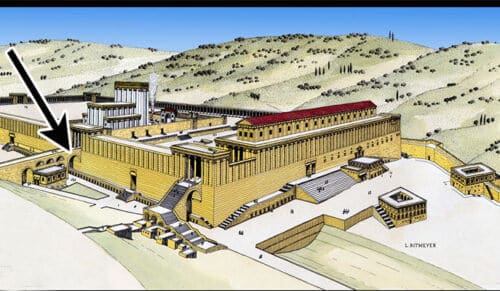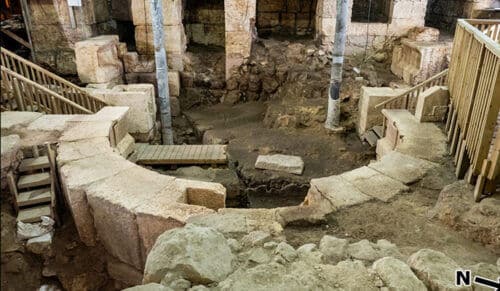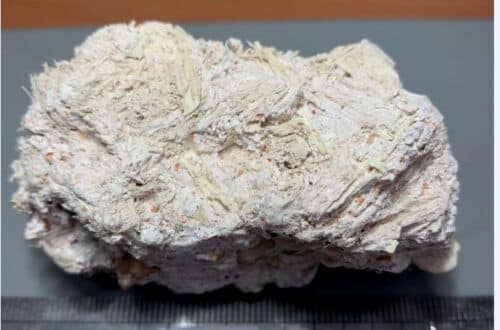Who was the early builder of Keshet Wilson in the tunnels of the Kotel?

Who built the Wilson Arch in the tunnels of the Western Wall? It was certainly not Charles Wilson, the land surveyor and British officer who operated in and around Jerusalem at the end of the 19th century and was the first to explore the arch named after him. Until recently, the archaeological community was divided between those who thought that the arch - a prominent structure in the Jerusalem landscape for hundreds of years that was used by believers on their way to the Second Temple - was built around the beginning of the era by Herod, while others believed that it was a later structure - perhaps even 600 years after Herod, in the period Early Islamic.
Prof. Elisabetta Boerto and Dr. Johanna Regev, from the Scientific Archeology Unit at the Weizmann Institute of Science, were entrusted with the project of scientific dating of the Ark within the framework of archaeological excavations in the tunnels of the Western Wall, carried out by the Antiquities Authority under the leadership of Dr. Joe Uziel, Tahila Lieberman and Dr. Avi Solomon ; The excavations were conducted at the initiative of the Western Wall Heritage Foundation as part of the tourist development of the site.

Prof. Boarto and Dr. Regev are experts in "micro-archaeology" - methods that allow for the accurate dating of archaeological finds through the analysis of organic remains, even the smallest ones. "Despite our experience in the field, we had to develop a unique strategy in this case, which includes a continuous presence in the excavation area," explains Prof. Boarto. "Archaeological research of urban buildings - and especially the dating of these buildings - is much more complicated than the dating carried out in other archaeological environments. The reason for this is that in an urban center that has been continuously inhabited for more than 2,000 years, the buildings have been in use for hundreds of years, and parts of them may have been destroyed and rebuilt."
The strategy included, among other things, a search for remains of cement that was used to glue the stones of the arch together. This material is created at high temperatures while adding organic aggregates aimed at giving it desirable properties. These aggregates may be, for example, seeds embedded in cement. One of the challenges faced by the researchers was to determine whether the remains of the charred seeds they found were indeed an original component of the plaster - and whether the plaster was part of the original construction or perhaps added as part of a late renovation. In addition, they will date seeds that are under the foundation stones of the building, assuming that they are earlier than the initial construction date. In the D-REAMS laboratory at the institute, Prof. Boarto and the research team analyzed the plaster and the charred materials that came from the excavation site using a mass spectrometry accelerator in order to discover their composition and properties and to determine their age.
The seeds found among the large arch stones were dated to the period before the destruction of Jerusalem, in AD 70 - that is, to the days of the Roman commissioners, the most famous of whom is Pontius Pilate.

Dr. Uziel from the Antiquities Authority says: "Micro-archaeology has provided decisive proof of a long-standing archaeological mystery - the mystery of dating the Wilson Arch. The arch was part of a massive bridge that led believers to the Temple Mount and was built as part of the construction of the Western Wall of the Temple Mount complex, about 2,000 years ago. In the joint research, we were able to determine that the arch - which held one of the main roads that led to the Second Temple - was built in two stages; In the first stage, a bridge was built in the days of Herod, or shortly after, with a width of 7.5 meters. In the second phase, a few decades later, the bridge was doubled and stood at 15 meters. The size and stability of the bridge testify to the great importance of the Temple Mount complex in the days of the Second Temple, where thousands of people gathered to participate in ceremonies, especially in the three pilgrimages.
At the same time, the team of archaeologists will date another piece of Jerusalem's history - a small, theater-like structure built under the Wilson Arch. The carbon dating indicated that the construction of the theater probably began shortly before a significant time in the history of the Jewish people - the outbreak of the Bar Kochba Revolt, in 132 AD - and not after the death of Emperor Hadrian. In the end, the research group dated 33 archaeological samples from many different places at the excavation site, covering a period of more than 1,000 years of Jerusalem's history.
"Without micro-archaeology - it would have been impossible to solve the puzzle of Wilson's arch," says Prof. Boarto. "We have shown that the great accuracy of our laboratory results, even when it comes to samples weighing a few milligrams, makes it possible to decide questions of dating with a high level of certainty. We believe that this method can solve other archaeological puzzles that until now were not thought that carbon dating could provide a sufficiently accurate answer."
The microarchaeology dating project is part of a broader pioneering project of carbon 14 dating in Jerusalem, which seeks to date the layers of life in Jerusalem throughout the ages using a precise scientific method. The project, with the participation of Prof. Yuval Gadot from Tel Aviv University and Dr. Doron Ben-Ami from the Antiquities Authority, is funded by the National Science Foundation.
More of the topic in Hayadan:
- In the tunnels of the Western Wall, new layers are revealed to the depth of the Western Wall, as well as an ancient Roman theater
- A 2000-year-old testimony to the days of the siege in Jerusalem; And more in the capital: an 1,800-year-old section of a Roman road was uncovered
- The quarry from which the stones were brought for the expansion of the temple by Herod was discovered

One response
The article talks about a theater-like structure under the Wilson Arch, which is consistent with my claims for years both in books, in articles (some in "Hidan") and in lectures in Israel and abroad, such as following the Los Angeles Olympics in 1984. According to my opinion, the building was erected at the behest of Yason the High Priest of Greece between 175 and 170 BC and was probably renewed, renovated and expanded at the initiative of King Herod. We find such a phenomenon of a close geographical connection between a temple or a synagogue in Tiberias at the initiative of Herod Antipas next to the Hellenistic stadium, and even in the Tarikai (tower) north of Tiberias, in Sardis in Asia Minor and other sites. The said building in Jerusalem probably began to be built in the days of Yason next to Pleiastra (a kind of high school for wrestling in the pre-gymnasium exam) and reached architectural maturity in the days of King Herod, at which time "Cassitus" was added to it - a running track and more. In any case, the Hellenistic and Hellenistic sports structures were very modest and very natural, unlike the "modern" ones of the Roman culture for generations.